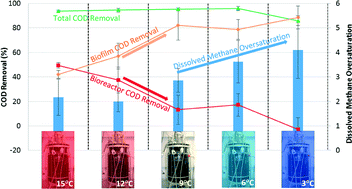Anaerobic membrane bioreactor treatment of domestic wastewater at psychrophilic temperatures ranging from 15 °C to 3 °C†
Abstract
Anaerobic membrane bioreactor (AnMBR) treatment of a simulated domestic wastewater was evaluated at psychrophilic temperatures of 15, 12, 9, 6, and 3 °C. Chemical oxygen demand (COD) removal >95% was achieved at temperatures as low as 6 °C, but fell to 86% at 3 °C. As temperature decreased, soluble COD in the bioreactor increased suggesting a reduction in suspended biomass activity. The high total COD removal was maintained via biological activity in the membrane biofilm, which resulted in significant dissolved methane oversaturation in the permeate. Sequencing of 16S rRNA suggested that the biofilm's metabolic diversity increased as temperature decreased in response to a greater flux of complex organics into the biofilm due to temperature-based suspended biomass inhibition. Hydrogenotrophic methanogenesis as opposed to aceticlastic methanogenesis was the preferred pathway in the biofilm, but not in the suspended biomass. This research demonstrated that AnMBR treatment of domestic wastewater at very low temperatures is feasible. However, it is important to develop technologies for dissolved methane recovery and to consider strategies to improve suspended biomass activity at low temperatures to decrease the reliance on biofilm treatment thereby decreasing dissolved methane oversaturation.


 Please wait while we load your content...
Please wait while we load your content...